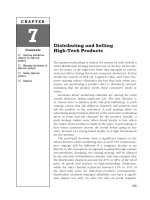FINDING STOCKS TO BUY AND SELL
Bạn đang xem bản rút gọn của tài liệu. Xem và tải ngay bản đầy đủ của tài liệu tại đây (111.96 KB, 10 trang )
PART THREE
FINDING
STOCKS TO BUY
AND SELL
10381_Sincere_03.c 7/18/03 10:58 AM Page 87
Copyright © 2004 by The McGraw-Hill Companies, Inc. Click here for Terms of Use.
This page intentionally left blank.
9
89
It’s Really
Fundamental:
Introduction to
Fundamental Analysis
The two main methods that people use to pick stocks are fundamental
analysis and technical analysis. Fundamental analysis is the study of
the underlying data that affect a corporation. Technical analysis, on the
other hand, is the study of a stock’s price.
Some of you may find that fundamental analysis is all you need in
order to be a successful investor. After all, understanding and applying
fundamental stock analysis helped make billionaire investor Warren
Buffett a very rich man. In addition, successful mutual fund managers,
such as Peter Lynch, Robert Rodriguez, and William Miller, to name a
few, have also used fundamental analysis to find stocks in high-quality
companies at bargain prices. If you want to learn about the stock mar-
ket, you must have at least a basic understanding of fundamental analy-
sis. It is worth your time to study it.
CHAPTER
10381_Sincere_03.c 7/18/03 10:58 AM Page 89
Copyright © 2004 by The McGraw-Hill Companies, Inc. Click here for Terms of Use.
Fundamental Analysis: An Overview
When you buy a stock on the basis of fundamental analysis, you are not
simply buying a piece of paper; rather, you are buying a piece of a cor-
poration. If you’re going to buy a stock, you should find out as much as
you can about the corporation. This is the essence of fundamental
analysis: You study the corporation to decide whether it is a worthwhile
investment.
This includes looking at a number of factors, including the com-
pany’s assets and liabilities, its earnings, the managers who are running
the company, the competition, the kind of business the company is in,
and the amount of debt it has. (You can find many of these items in the
balance sheet, a brief financial report of the corporation that will be
discussed shortly.) By using fundamental analysis, you should be able
to pick out stocks that offer you the best chance for profits. You want to
buy a stock whose price is reasonable when compared with its earn-
ings—what fundamental analysts call “fair value.”
You should know that fundamental analysis is one of the most popu-
lar methods of determining whether a stock is a good bargain or is better
left alone. If you have done your homework and closely studied all as-
pects of a corporation, you should be rewarded with a higher stock price.
Nevertheless, fundamental analysis is merely a tool to help you
find and evaluate which stocks offer good value. Like anything related
to the stock market, this method is more art than science. Just because
you use fundamental analysis doesn’t mean that you’ll make a lot of
money in the market. The more methods you learn, however, the better.
This will also give you a chance to determine whether fundamental
analysis is right for you.
The Concepts behind Fundamental Analysis
Learn Everything You Can about the Industry
The first thing an investor has to determine when engaging in funda-
mental analysis is what industry to look at. If we are in the middle of a
recession, when jobs are scarce and people are struggling to stay out of
90
U
NDERSTANDING
S
TOCKS
10381_Sincere_03.c 7/18/03 10:58 AM Page 90
debt, you might look at recession-proof industries like food, oil, and
retail. Once the country is out of the doldrums and jobs are plentiful, you
take a look at industries like technology that could take the market higher.
Peter Lynch, a successful fund manager of the 1980s and 1990s,
got many of his stock ideas by watching where his children shopped at
the mall. If you go to the mall and The Gap, Starbucks, Hott Topic, or
Victoria’s Secret is filled with shoppers, this is a clue that these stores
are making money. This doesn’t mean that you should run out and buy
stock in one of these companies—first you should use fundamental
analysis to find out everything you can about the company. You should
also take the time to read the annual report, call investor relations for an
investment packet, and log on to the company Web site. You don’t want
to invest a lot of money in a stock without finding out everything you
can about the company’s business. Ideally, the business will be simple
and understandable with good long-term prospects for the future.
Identify the Leading Company
Once you have identified the industry you want to invest in, you want
to choose companies that are stronger and more profitable than their
competition. Let’s say you want to invest in the retail sector because
you believe (after careful research) that people will flock to discount
stores that can save them money. What stores come to mind? Wal-
Mart? Home Depot? Walgreen’s? Exactly. Choose the stores that have
name brand recognition and that advertise heavily. These companies
are called industry leaders. If people are buying the company’s prod-
ucts, the company’s earnings will go up, which should cause the stock
price to rise. To find industry leaders, you want to look for companies
that have superior sales and earnings with little or no debt.
The financial newspaper Investor’s Business Daily rates the relative
strength of stocks in leading industries, giving them a score between 1
and 99. A relative strength rating higher than 90 is considered excellent.
You can also find information about industry leaders in the Value Line
Investment Survey, which can be found at the public library. (The Value
Line Investment Survey has loads of information about individual stocks
condensed on one page. Nearly all of the fundamental information you
need to know about a stock can be found in this periodical.)
IT
’
S REALLY FUNDAMENTAL
:
INTRODUCTION TO FUNDAMENTAL ANALYSIS
91
10381_Sincere_03.c 7/18/03 10:58 AM Page 91









